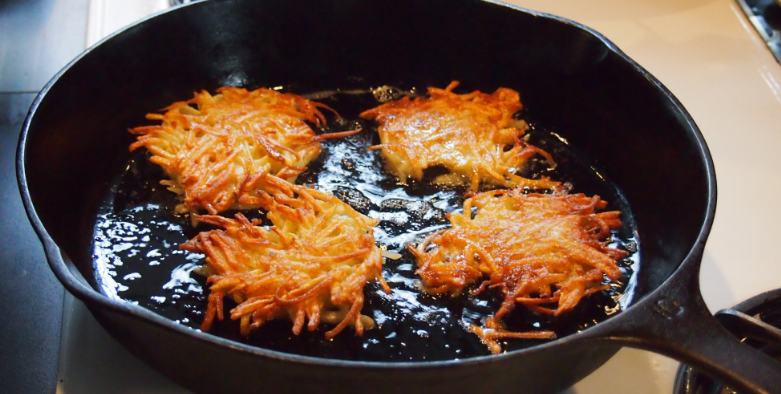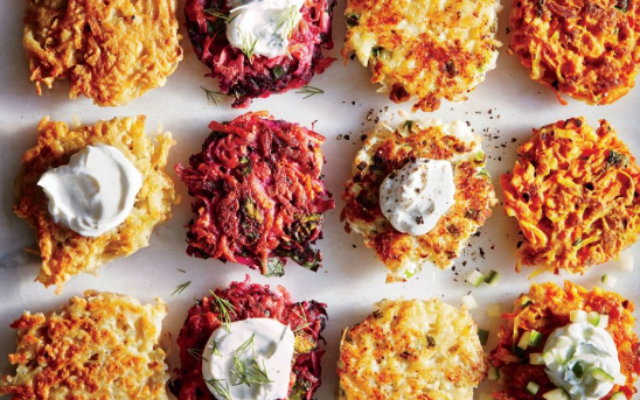New Twists on the Latke Tradition
Variations can include many of the root vegetables and even fruits.
Hot, crisp potato latkes with a lacy fringe of browned shreds is one of the glories of holiday cooking. According to Gil Marks, the late Jewish food historian, the original latkes were made from curd cheese fried in oil, but because oil was a luxury in many Northern and Eastern European homes, the pancakes were fried in schmaltz, rendered chicken fat.
Eventually this led to latkes made from buckwheat flour and eventually in the mid-19th century to latkes made from the lowly potato. There is no need however, to confine yourself to the starchy, high carbohydrate bombs of our Ashkenazi forefathers.
Latkes can be made with any number of root vegetables, or blended with potatoes to bring new textures and taste to an old favorite. Mark Bittman, the Jewish New York-based cookbook author in his comprehensive book, “How to Cook Everything Vegetarian,” suggests some easy additions to your traditional recipe.
Try shredded or finely chopped celery root, turnips, rutabagas, carrots, parsnips or beets in your latkes. Pick from winter squash that are so plentiful and economical now, like butternut or pumpkin, peeled and finely diced to combine with the potatoes.

Or drop the potatoes entirely and shred beets and carrots together and add apples for a colorful and distinct combination. Forget the winter vegetables and shred the apples, mix in some cinnamon and chopped dates, add a few toasted walnuts that have been broken up and sweeten with a teaspoon or two of sugar for a dessert latke, like those found in some Israeli homes.
Those fruits and vegetables with a high water content, like potatoes, apples, and carrots may need to be put in a couple of paper towels and wrung out to release the moisture. The less water there is, the crisper the final product.
You may need to add a couple of tablespoons of flour or even an egg to bind the product as it cooks. Allow the cooking oil to heat up enough so that you see some movement on the surface, and don’t crowd your latkes or they will not fully crisp up.
Remember to drain on double layers of paper towels after they come out of the hot oil.
If you are averse to high calories and high fat, latkes can be baked in the oven and sprayed on both sides with a thin sheen of olive, hazelnut or walnut oil.
Here’s a new twist on potato latkes and sour cream.
Sweet Potato Latkes with Lemon Creme Fraiche
 For the lemon crème fraîche:
For the lemon crème fraîche:
2 tablespoons lemon juice
1 teaspoon lemon zest, grated finely
1 bunch chives, chopped finely
1 cup crème fraîche (available
at Trader Joe’s)
For the latkes:
2 pounds sweet potatoes
1 large Spanish onion, chopped very
finely
3 eggs, beaten
1/3 cup flour
¼ cup matzah
Kosher salt, to taste
Pinch of cinnamon
Pinch of ancho chile powder
Pinch of nutmeg
1 teaspoon baking soda
¼ cup canola oil
Combine all of the ingredients for the lemon crème fraiche in a bowl and mix well. Place in the refrigerator until chilled, to allow all of the flavors to combine.
Shred the potatoes for the latkes with the fine shredding attachment of your food processor or a hand grater. Place in a colander set over another bowl and squeeze out the excess moisture as much as possible.
Put the shredded potato in a bowl and add the onion, eggs, flour and matzah. Season with salt, to taste. Mix in the spices and baking soda.
In a large heavy skillet, heat the canola oil over high heat until very hot but not smoking. Take ¼ cup of batter, squeezing out any remaining moisture, and drop into the hot oil. Flatten with a spatula and reduce heat to medium. (Don’t put more than a few latkes in the pan at one time or the oil temperature will drop.)
Watch the heat. Fry until golden brown on one side, then turn over and fry the other side. Don’t turn more than once or they will start to get soggy. Put finished latkes on dry paper towels to drain.
Serve immediately with the lemon crème fraîche. ìì




comments